When shopping for kids’ exercise bouncers, look for key safety certifications including EN 71-14, CE marking, GS TÜV certification, and ASTM F381 compliance. These standards verify essential safety features like structural integrity, weight capacity, and non-toxic materials. You’ll want products that meet age-specific guidelines and weight limits established by these rigorous testing protocols. Properly certified bouncers minimize injury risks while maximizing developmental benefits for your child. Discover how these certifications translate to real-world protection for your little jumper.
Key Safety Certifications Every Exercise Bouncer Should Have
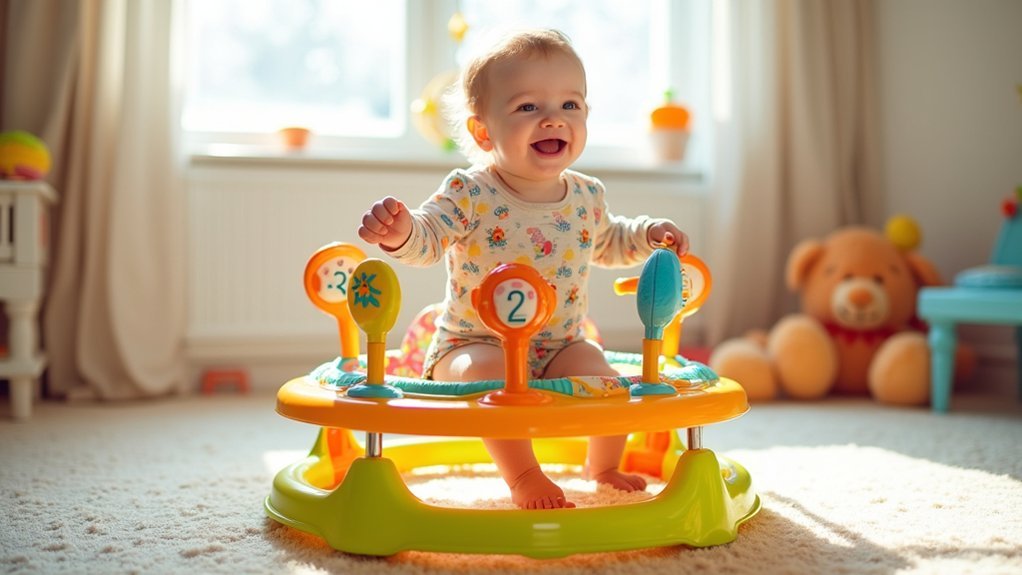
When shopping for an exercise bouncer for your child, safety certifications should be your top priority.
Look specifically for the EN 71-14 certification, which verifies the bouncer meets essential safety requirements for children’s use both indoors and outdoors.
The CE marking is equally important, as it confirms compliance with EU health and safety standards.
CE markings provide essential verification that your child’s bouncer meets rigorous European safety standards.
For additional assurance, check for the GS TÜV certification, which indicates the product has undergone thorough safety testing by TÜV Rheinland.
If you’re purchasing for public spaces, make sure the bouncer complies with EN 1176 guidelines for playground equipment.
Finally, verify REACH Regulation compliance, which guarantees the bouncer is free from hazardous materials that could harm your child during play.
Understanding EN 71-14: The European Standard for Trampoline Safety
When checking your child’s exercise bouncer for safety, you’ll want to confirm it meets EN 71-14’s key components including frame stability, padding coverage, and maximum jump height limitations.
This European standard requires trampolines to undergo rigorous testing for impact resistance, material durability, and structural integrity under various simulated conditions.
You can verify compliance by looking for the EN 71-14 certification mark on the product or packaging, which indicates the manufacturer has submitted their trampoline for independent laboratory assessment.
Key Certification Components
Although many parents focus primarily on fun when purchasing exercise bouncers for their children, understanding safety certifications is crucial for making informed decisions.
When examining EN 71-14 certification, you’ll find several critical components that guarantee your child’s safety. The standard requires extensive testing of structural integrity and stability, confirming that the trampoline can withstand regular use without failing. Protective padding must cover all rigid structures, while secure netting systems prevent falls. Proper anchoring requirements guarantee the bouncer won’t tip during active play.
These safety standards aren’t static—they’re regularly updated to incorporate new technologies and materials.
When you’re shopping for an exercise bouncer, look specifically for EN 71-14 compliance, which signals that the product has undergone rigorous safety evaluations and meets Europe’s strict requirements for domestic trampolines.
Testing Requirements Explained
Since your child’s safety depends on rigorous testing procedures, understanding EN 71-14 requirements gives you essential insight into what makes exercise bouncers truly safe.
This European standard establishes extensive safety requirements that manufacturers must meet before their trampolines reach your home.
The testing process evaluates four critical elements:
- Structural integrity – verifying the frame can withstand repeated jumping without failure
- Impact absorption – ensuring the surface properly cushions falls to prevent injuries
- Protective padding – testing covers over springs and frame edges to shield users from hard surfaces
- Stability assessment – confirming the trampoline won’t tip over during normal use
When shopping for an exercise bouncer, look for certification to EN 71-14 as your assurance that it’s been thoroughly tested against these safety requirements.
Compliance Verification Process
Understanding how exercise bouncers achieve EN 71-14 certification serves as your roadmap to selecting truly safe products for your children.
Manufacturers must navigate a thorough verification process that involves testing all critical components—from frame stability to padding effectiveness.
To obtain safety certification, products undergo evaluation by authorized testing bodies that meticulously assess each element against strict benchmarks.
Once a product passes these rigorous tests, manufacturers receive official certification confirming EN 71-14 compliance.
You’ll notice that certified products feature clear documentation of this status.
The British Standards Institution conducts regular audits to maintain ongoing compliance, giving you confidence in your purchase.
Additionally, certified bouncers include mandatory safety instructions and warnings, providing you with essential guidance for proper setup and use.
The Role of GS TÜV Certification in Children’s Rebounding Equipment
When you’re shopping for children’s exercise bouncers, GS TÜV Certification offers vital safety assurance through its thorough testing standards.
This internationally recognized certification evaluates equipment for structural integrity, material quality, and effective safety features like padding, while ensuring products meet strict load capacity and stability requirements.
Regular manufacturing audits maintain these high safety standards, giving you confidence that your child’s rebounding equipment won’t fail during active play.
GS TÜV Testing Standards
As parents search for safe exercise equipment for their children, the GS TÜV certification stands out as a critical indicator of quality and safety.
When you’re evaluating trampoline safety for your kids, understanding these rigorous testing standards gives you confidence in your purchasing decisions.
The GS TÜV testing process includes:
- Structural integrity assessments – ensuring the bouncer can withstand repeated use without failing
- Material safety analysis – verifying all components are free from harmful chemicals and toxins
- Hazard identification – testing for potential pinch points, sharp edges, or entrapment risks
- Regular manufacturing audits – confirming consistent quality through periodic factory inspections
These thorough standards aren’t just one-time evaluations but ongoing commitments to safety that manufacturers must maintain to keep their certification status.
Certification Benefits Explained
The GS TÜV certification provides far more than just a logo on packaging—it delivers critical protection for your child’s safety during playtime.
When you purchase rebounding equipment with this mark, you’re getting the assurance that it has undergone exhaustive testing for structural integrity, material safety, and potential hazards.
This certification guarantees compliance with European safety regulations, giving you confidence in your purchase decision. Schools and recreational facilities often require this certification for their equipment, recognizing its stringent standards.
For manufacturers, the GS TÜV mark enhances brand reputation by demonstrating commitment to children’s safety.
You’ll find that certified equipment typically offers better construction and durability, reducing injury risks while your children enjoy their exercise activities.
This investment in certified equipment ultimately protects what matters most—your child’s wellbeing.
How ASTM F381 Standards Protect Young Bouncers
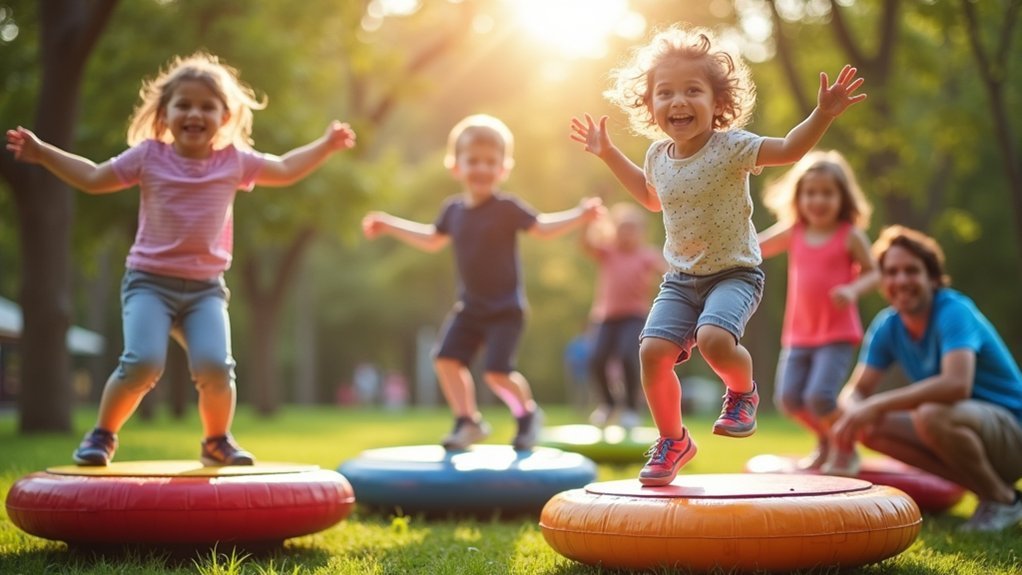
Safety standards form the backbone of protection for children enjoying bounce houses, and ASTM F381 stands as the premier certification guaranteeing their wellbeing.
When you purchase a bouncer with this certification, you’re investing in equipment that meets rigorous safety criteria designed specifically to protect your child.
The ASTM F381 standard safeguards young bouncers through:
ASTM F381 doesn’t just set standards—it creates invisible shields that protect children through every bounce, jump, and tumble.
- Structural integrity requirements that prevent collapses and guarantee stability during active play
- Impact attenuation specifications that minimize injury risks from falls and collisions
- Non-toxic material mandates that keep harmful substances away from your child
- Comprehensive testing protocols that verify ongoing safety compliance
These protections work together to create a secure play environment, giving you confidence while your children enjoy the developmental benefits of bouncing.
Evaluating Weight Limits and Age Recommendations on Certified Products
While ASTM F381 certification establishes foundational safety parameters, parents must understand how to correctly interpret the weight limits and age recommendations displayed on certified exercise bouncers.
You’ll find that most certified bouncers support between 50-250 pounds, depending on their design and materials. Always check that products comply with standards like EN 71-14, which specifically addresses weight limits for trampoline products.
When shopping, locate the manufacturer’s guidelines regarding maximum user weight and appropriate age ranges—typically recommending use for children 3 and older. These aren’t mere suggestions; they’re critical safety parameters based on physical development milestones.
Don’t skip regular assessments of your bouncer’s condition. Continued adherence to the manufacturer’s weight and age specifications guarantees both safety and compliance with certification standards that protect your child.
Safety Features Required by Global Certification Bodies
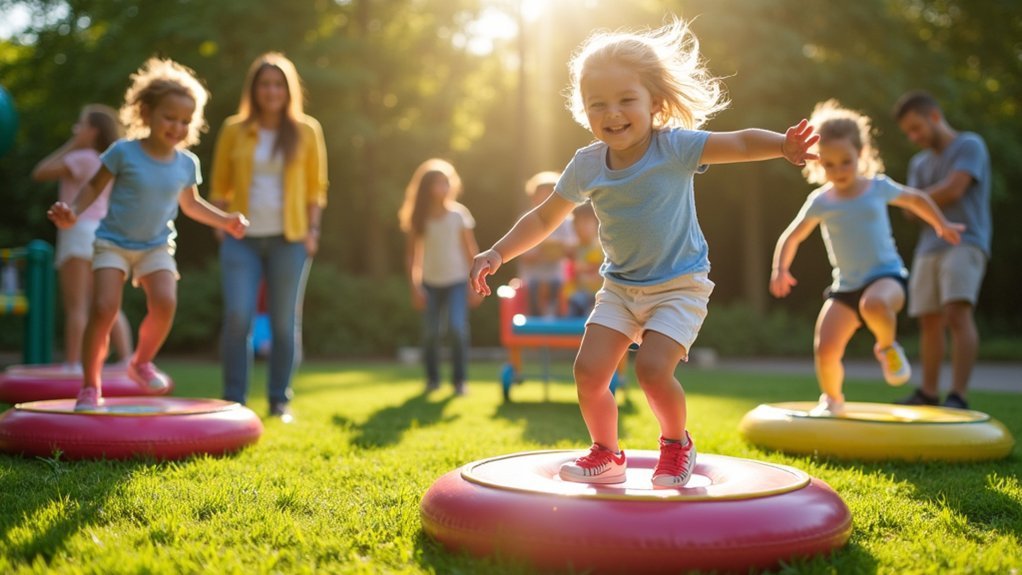
When selecting exercise bouncers for children, you’ll need to understand the rigorous safety features mandated by global certification bodies. The BSI requires compliance with BS EN 71-14:2018, while the CEN enforces EN 1176 standards for public playground equipment.
These certifications demand specific safety elements:
- Structural integrity testing – ensuring frames can withstand typical usage without failure
- Protective padding requirements – covering all hard surfaces and potential impact points
- Material safety compliance with REACH Regulations – prohibiting hazardous substances in manufacturing
- Mandatory inspection protocols – requiring regular maintenance checks to identify potential hazards
Understanding these certification requirements helps you select exercise bouncers that meet global safety standards, reducing injury risks and providing peace of mind during your child’s playtime.
Identifying Legitimate Certification Marks When Shopping for Children’s Bouncers
As you browse through various children’s exercise bouncers, recognizing legitimate certification marks becomes essential for ensuring your child’s safety.
Look specifically for BS EN 71-14:2018 certification, which indicates compliance with safety requirements for domestic trampolines safe for users.
The CE marking is another vital indicator that the bouncer meets European health and safety standards through rigorous testing.
You’ll also want to identify GS TÜV Certification, confirming the product has been tested by the respected TÜV Rheinland organization.
Legitimate certifications should be clearly displayed on packaging or the manufacturer’s website.
Don’t forget to research the manufacturer’s reputation and check if they’re members of organizations like the Trampoline and Play Equipment Association, which promotes quality standards in the industry.
Frequently Asked Questions
How Often Should Certified Exercise Bouncers Be Inspected at Home?
You should inspect your certified exercise bouncers before each use, but also conduct thorough checks monthly. Look for tears, loose springs, or damaged frames that could compromise safety during your child’s bouncing sessions.
Can Certified Bouncers Be Safely Used Outdoors Year-Round?
You shouldn’t use certified bouncers outdoors year-round. They’re not designed for constant exposure to elements. Rain, UV rays, and temperature extremes damage materials. Store them indoors when not in use for safety and longevity.
Do Certification Standards Differ for Indoor Versus Outdoor Bouncers?
Yes, indoor and outdoor bouncer certification standards differ. You’ll find outdoor models require UV-resistance testing, weather durability certifications, and anchoring specifications, while indoor versions focus more on floor protection and spatial requirements.
How Do Certifications Address Children With Special Needs?
You’ll find certifications require accessibility features, staff training for special needs supervision, and modifications like sensory-friendly options. They often mandate proper anchoring, weight limits, and evacuation protocols for children with mobility challenges.
Are Certification Requirements Different for Inflatable Versus Spring-Based Bouncers?
Yes, certification requirements differ markedly. You’ll find that inflatables must meet ASTM F2374 standards, while spring-based bouncers follow ASTM F381 guidelines. Each type requires specific safety testing for their unique hazards and designs.
In Summary
When you’re shopping for exercise bouncers, always look for key certifications like EN 71-14, GS TÜV, and ASTM F381. These standards guarantee the equipment meets strict safety requirements for your child. Don’t ignore weight limits and age recommendations—they’re there for a reason. Legitimate certification marks are your best assurance that the bouncer will provide safe, worry-free exercise for your kids.
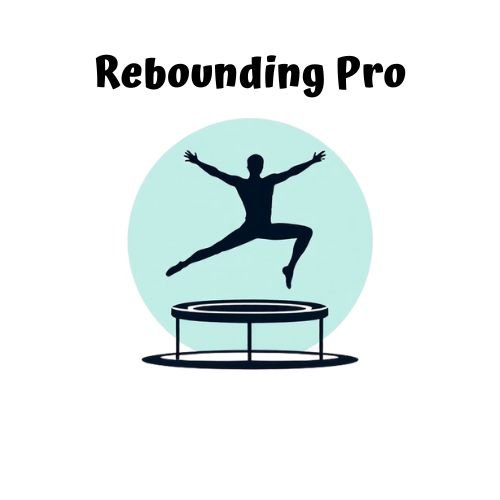
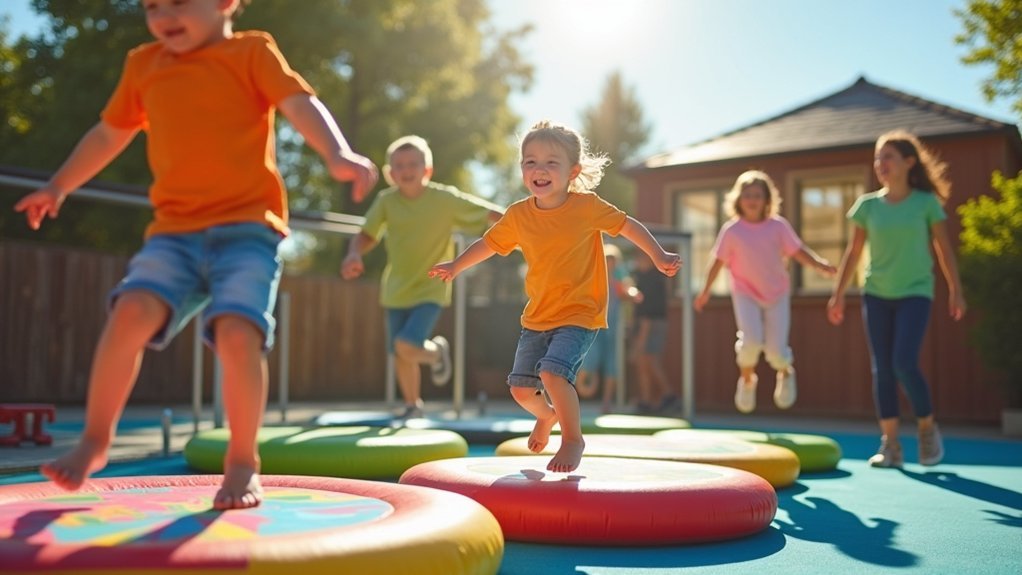
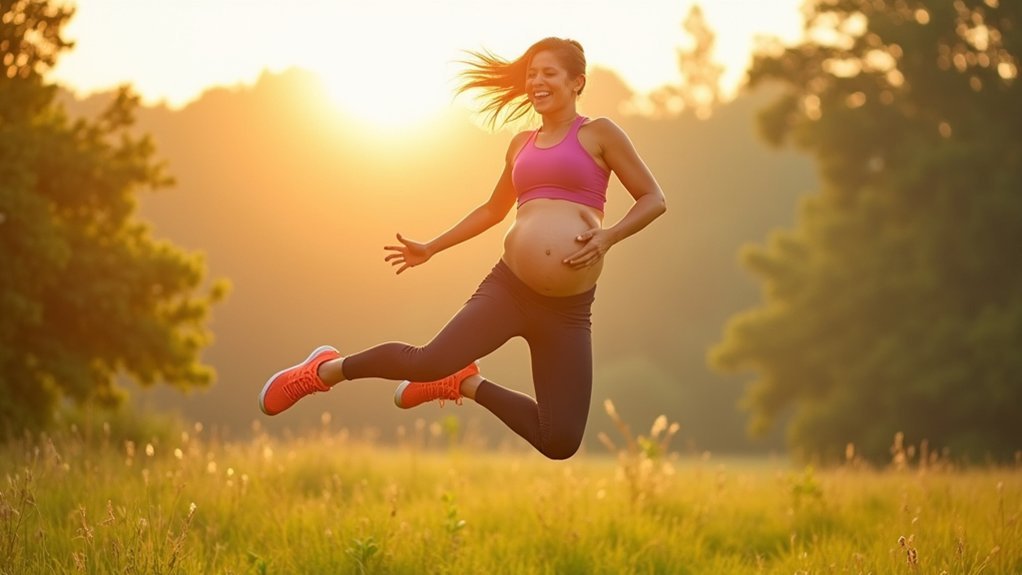
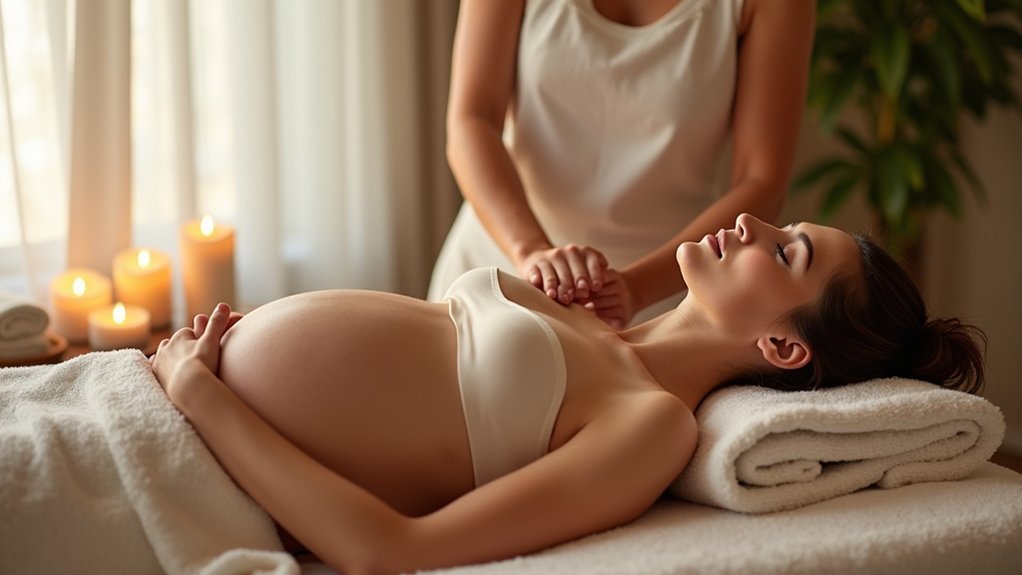
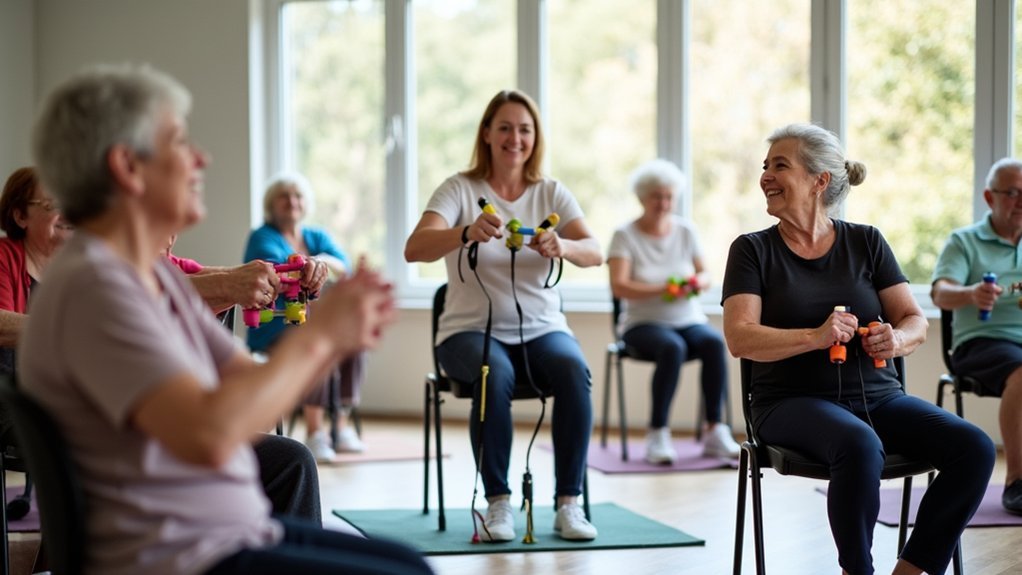
Leave a Reply